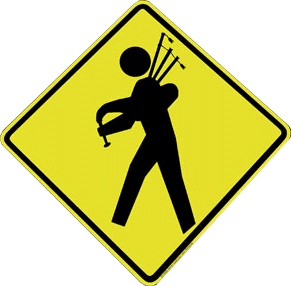 |
|
Featured Piper
|

|
|
Piper to the Sovereign
In 1842, Queen Victoria with her husband Albert, took
a trip to Taymouth Castle. She heard John Ban
MacKenzie playing the bagpipes and was delighted.
She sent a letter to her mother describing the event
and told her that she had decided to have a piper. The
Marquis of Breadalbane recommended Angus
MacKay as the Piper for the Queen. MacKay accepted
the job and moved to London where he became the
first Piper to the Sovereign.
Early on, the Piper to the Sovereign had several
duties, including serving as footman in the garden,
waiting at dinner, greeting visitors and escorting them,
and taking orders from the Sergeant Footman. Now,
the Sovereign's Piper plays every weekday morning at
9:00am outside the Queen's window when she is at
Windsor Castle, Buckingham Palace, the Palace of
Holyroodhouse, and Balmoral. He also plays at
special events and accompanies the Queen to
various audiences. While at Balmoral during the
summer, the Queen has an unofficial rule that the
same tunes can not be played twice.
The Queen's Piper, as he is sometimes called,
coordinates twelve pipers to play in the dining room
for official state banquets. He plays at the Queen's
dinner table each evening at Balmoral,
Holyroodhouse and Windsor.
To date, there have been 12 Piper's to the Sovereign.
The position used to be held until the Piper's death;
however this is no longer the case. In 1965, the post
of Piper to the Sovereign was removed from the Civil
List, and has since been given to a serving soldier
and experienced army Pipe Major. The Piper would
become a Master of the Household's Department at
Buckingham Palace and retain his position until his
enlistment expires (maximum of 22 years). The
Queen personally interviews Pipers for the position.
The current Piper to the Sovereign is PM Alistair
Cuthbertson. He was Pipe Major to the 1st Battalion
the Royal Scots when he took this position.
We Want to Feature your Pipe Band!!
Send us an email with a band photo and a short write
up. Include any links or videos that you would
like us to post.
|
|
|
|
|
|
|
|
 |
|
Events
|

|
|
February 21 Winnipeg
Scottish Festival
March 7 @ 5pm- 6pm Wilson School of
Highland Dance 20th Anniversary at the Odeon Events
Centre
March 11-15 Vancouver
Celticfest
March 17 4:00pm-11pm Irish Fest at Odeon
Events Centre, contact Tera Maguire
tera.maguire@usask.cam
March 17 Happy St. Patrick's Day
This Month's Video Clip:
This video features Warner Bros' favorite rabbit, Bugs
Bunny, who makes a wrong turn and ends up in
Scotland.
My
Bunny Lies Over the Sea
|
|
|
|
|
|
More Upcoming Events
|
|
 |
|
Featured Article
|

|
|
Preparing to Compete
As competition season begins to approach, here are
a few tips that may be useful for your preparation.
Make sure that you join your Piping Association. Send
in your registration for competitions as soon as
possible, as those who sign in last often perform first.
Select an appropriate tune that you can play
well. It's better to play an easy tune well than to play a
harder tune poorly. Play in front of others to get the
feel of it. There are many distractions at these events,
so the more the tune is internalized, the better
prepared you will be. Watch other competitions to see
how they run and how other pipers perform. You
should check to see if there are marching
requirements and, if so, practice with marching. It's a
good idea to have a back up reed ready, just in case.
Try on your entire outfit and practice in it.
Double check your instrument to make sure that the
stock joints are tight, tuning pins are sliding correctly,
and any hoses are not kinked. It's also a good idea to
have directions to the games and print off a map, just
to be sure.
You will want to leave early to give yourself at least an
hour on site before your competition. Find the
competition area and check in. Make sure that they
have you registered for the correct events. Check the
playing area for any possible hazards, like holes in the
ground. Check your drone and chanter reeds. Warm up with some
exercises to get your tuning in place and your fingers
warmed up. Don't overdue it, though, so you still have
enough energy for your performance. Check to see if
the event is progressing on time. Occasionally, they
can be ahead of schedule, or behind schedule, so it's
a good idea to keep checking in.
When it is your turn to perform, walk up to the judge.
Make sure that you've left some room for them to finish
scoring the last piper. The judge will often make eye
contact with you to signal that it's your turn. Walk up to
the judge, make eye contact, introduce yourself and
state the tune you will be playing. Then, take your time
before starting to play. If you need to do any last
minute tuning, turn away from the judge. When ready,
face the judge & give a nod to signal that you are
ready. Although you may want to rush through it to get
it over with, try to take your time and try to keep the
correct tempo. Try to keep your focus and avoid
looking at the crowd or judges, which may distract
you. When finished, pause briefly before exiting. Make
eye contact with the judge and say thank you. About
an hour or so after the event is over, results will be
posted and you can get your evaluation.
The most important things to remember are try to relax
and have fun!
|
|
|
|
|
|
Here are some items that you may need to keep your pipes in good playing condition.
|
|